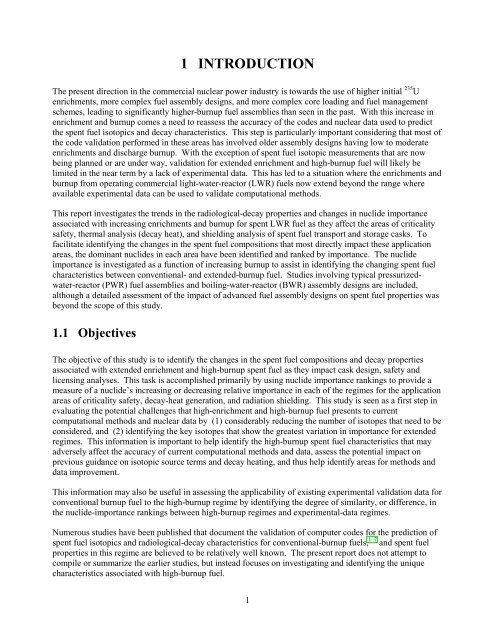nureg/cr-6700 - Oak Ridge National Laboratory
nureg/cr-6700 - Oak Ridge National Laboratory
nureg/cr-6700 - Oak Ridge National Laboratory
Create successful ePaper yourself
Turn your PDF publications into a flip-book with our unique Google optimized e-Paper software.
1 INTRODUCTION<br />
The present direction in the commercial nuclear power industry is towards the use of higher initial 235 U<br />
enrichments, more complex fuel assembly designs, and more complex core loading and fuel management<br />
schemes, leading to significantly higher-burnup fuel assemblies than seen in the past. With this in<strong>cr</strong>ease in<br />
enrichment and burnup comes a need to reassess the accuracy of the codes and nuclear data used to predict<br />
the spent fuel isotopics and decay characteristics. This step is particularly important considering that most of<br />
the code validation performed in these areas has involved older assembly designs having low to moderate<br />
enrichments and discharge burnup. With the exception of spent fuel isotopic measurements that are now<br />
being planned or are under way, validation for extended enrichment and high-burnup fuel will likely be<br />
limited in the near term by a lack of experimental data. This has led to a situation where the enrichments and<br />
burnup from operating commercial light-water-reactor (LWR) fuels now extend beyond the range where<br />
available experimental data can be used to validate computational methods.<br />
This report investigates the trends in the radiological-decay properties and changes in nuclide importance<br />
associated with in<strong>cr</strong>easing enrichments and burnup for spent LWR fuel as they affect the areas of <strong>cr</strong>iticality<br />
safety, thermal analysis (decay heat), and shielding analysis of spent fuel transport and storage casks. To<br />
facilitate identifying the changes in the spent fuel compositions that most directly impact these application<br />
areas, the dominant nuclides in each area have been identified and ranked by importance. The nuclide<br />
importance is investigated as a function of in<strong>cr</strong>easing burnup to assist in identifying the changing spent fuel<br />
characteristics between conventional- and extended-burnup fuel. Studies involving typical pressurizedwater-reactor<br />
(PWR) fuel assemblies and boiling-water-reactor (BWR) assembly designs are included,<br />
although a detailed assessment of the impact of advanced fuel assembly designs on spent fuel properties was<br />
beyond the scope of this study.<br />
1.1 Objectives<br />
The objective of this study is to identify the changes in the spent fuel compositions and decay properties<br />
associated with extended enrichment and high-burnup spent fuel as they impact cask design, safety and<br />
licensing analyses. This task is accomplished primarily by using nuclide importance rankings to provide a<br />
measure of a nuclide’s in<strong>cr</strong>easing or de<strong>cr</strong>easing relative importance in each of the regimes for the application<br />
areas of <strong>cr</strong>iticality safety, decay-heat generation, and radiation shielding. This study is seen as a first step in<br />
evaluating the potential challenges that high-enrichment and high-burnup fuel presents to current<br />
computational methods and nuclear data by (1) considerably reducing the number of isotopes that need to be<br />
considered, and (2) identifying the key isotopes that show the greatest variation in importance for extended<br />
regimes. This information is important to help identify the high-burnup spent fuel characteristics that may<br />
adversely affect the accuracy of current computational methods and data, assess the potential impact on<br />
previous guidance on isotopic source terms and decay heating, and thus help identify areas for methods and<br />
data improvement.<br />
This information may also be useful in assessing the applicability of existing experimental validation data for<br />
conventional burnup fuel to the high-burnup regime by identifying the degree of similarity, or difference, in<br />
the nuclide-importance rankings between high-burnup regimes and experimental-data regimes.<br />
Numerous studies have been published that document the validation of computer codes for the prediction of<br />
spent fuel isotopics and radiological-decay characteristics for conventional-burnup fuels, 1–7 and spent fuel<br />
properties in this regime are believed to be relatively well known. The present report does not attempt to<br />
compile or summarize the earlier studies, but instead focuses on investigating and identifying the unique<br />
characteristics associated with high-burnup fuel.<br />
1

















